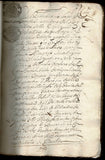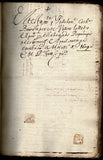Manuscript Censos in the Seventeenth Century
Year: 1606-1660
Publisher: Manuscript
Place: Puebla
Description:
97 leaves. Folio (12 ¾" x 8 ¾") bound in half cloth over beige cloth. This bound gathering holds all the closed loans in Puebla in the year 1606-1660. All these loans were handled by Convents or Capellanías. It's an interesting and early item that sheds light on how the churched worked in the colonial era, and it also provides a lot of information about properties and life in the XVII century in Colonial Mexico.
This volume records censos finalized in the year 1660, including some which originated as early as 1606. Most documents begin on a piece of sealed paper, extend to approximately 2 to 14 leaves, and conclude with docketing on the verso of the final leaf noting "senso" or "chancelacion."
By the last third of the eighteenth century, the various elements that had permitted the church to flourish economically—crown support, creole largesse, Indian and Black labor—began to come apart. At first, because of the peculiar way in which the church was involved in colonial economy and society, the clergy and creole property owners stood against the crown, an alliance that emerged in the conflict over the expulsion of the Jesuits and the Consolidation of 1804.
When property owners sat down with a notary or church official to work out contracts that would commit a certain annual interest, or rédito, to the church, they usually used the verb imponer. Thus, a hacendado in eighteenth-century Puebla "imponía una capellanía a cinco por ciento." The property was then said to "recognize," or reconocer, this obligation. The very same verbs were used to describe debt resulting from a loan. Thus, capital impuesto or capital reconocido are neutral terms and do not reveal whether the transaction was lien or loan. "Indebted" (endeudado) was rarely used; properties were burdened, or gravado, another unrevealing term. Hipotecado, which also may be the recognition of either lien or loan, became more common in the nineteenth century. Some terms were unambiguous: a préstamo or depósito (at times depósito irregular) were always loans of money in the modern sense. Censo, a word no longer used in its colonial sense, has caused the most trouble because it was both the generic term for all encumbrance or lien and also the common word for a loan, or préstamo. Even the apparently straightforward colocado a censo can mean either the imposition of an annuity or a loan. The problem of vocabulary becomes more acute in translation. Imponer or capital impuesto are most commonly rendered as "investment" in English; censo becomes "mortgage," colocado a censo, inevitably, "money lent" with the accompanying violence to meaning. Beyond that, the consolidación de vales becomes the "calling in of loans," and we often read of the "circulation of capital" when nothing moves except the author's imagination.
The nature of censos, pious works, aniversarios, memorias, capellanías, and depósitos, all of them weighed upon property owners and all yielded revenue to the church. First, the censo enfiteútico: this device was used when a property owner transferred the use of property (dominio útil) to another person in return for an annual payment based on a contract that lies somewhere between a sale and a rental. econd, the censo reservativo or censo al quitar was very similar to the enfiteútico except that the property owner retained even less control over the property because he gave up the rights of both tanto and laudemio. The third kind of censo was the most widely used and is the most ambiguous and confusing to interpret. The censo consignativo had a variety of uses. It was often synonymous with capellanía, which will be discussed below, and it served to guarantee annuities to individuals. In such a case, the owner imposed a censo, the capital value of which was calculated in monetary terms, on his property in order to guarantee an annuity, usually of 5 percent, on that capital value. (HAHR Volume 73 Issue 4)
Condition:
Split at front hinge. Underlining of introductory leaves. Corners bumped and rubbed, spine ends rubbed. Boards stained. Provenance from a long-time collector who purchased at auction and who is liquidating his collection.

























